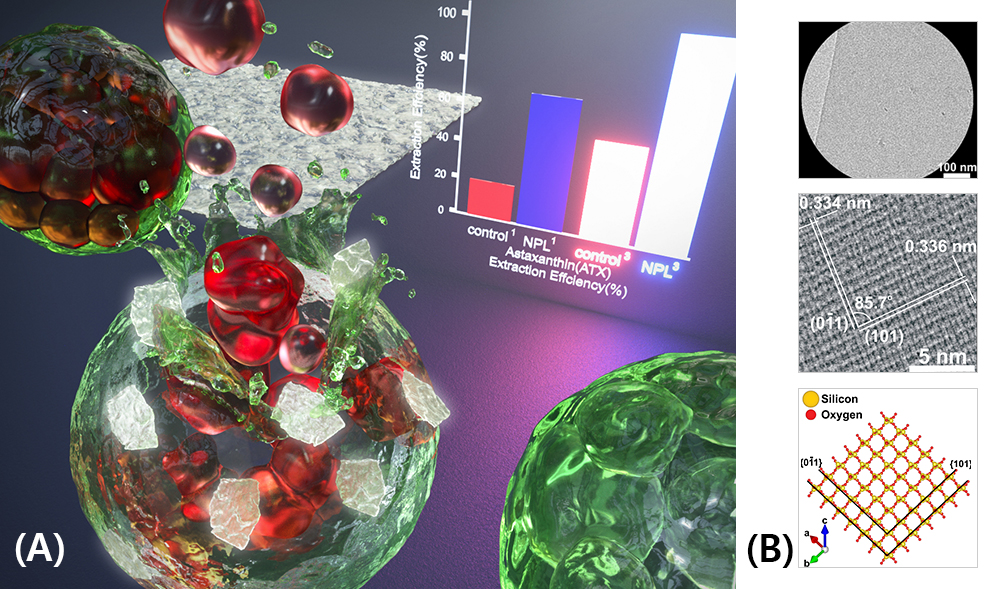- 작성일
- 2021.03.26
- 수정일
- 2021.03.26
- 작성자
- 김성애
- 조회수
- 270
[PNU리서치] 정성욱·오유관 교수팀, 미세조류 파쇄 나노면도날 개발(20-12-21)
맞춤형 석영 나노면도날로 마이크로 미세조류 파쇄해 유용물질 추출
단단하고 두꺼운 미세조류를 쉽게 파쇄해 그로부터 유용물질을 효과적으로 추출할 수 있는 나노면도날이 개발됐다. 유용 미세조류를 이용한 바이오연료 및 화학소재 생산에 기여할 것으로 기대된다.
응용화학공학부 정성욱 교수와 오유관 교수 연구팀은 석영 결정 소재 나노면도날로 미세조류 바이오매스를 더욱 효과적으로 파쇄할 수 있는 기술 개발에 성공했다. 이번 연구 성과는 화학공학 분야 국제학술지 『케미컬 엔지니어링 저널(Chemical Engineering Journal)』에 11월 3일 게재됐다.
* 논문명: Hydorthermal synthesis of novel two-dimensional α?quartz nanoplates and their applications in energy-saving, high-efficiency, microalgal biorefineries
* 논문 링크: https://doi.org/10.1016/j.cej.2020.127467
<저자. 왼쪽부터 정성욱 교수, 오유관 교수, 문규섭 석박사통합과정생, 이나경 박사후연구원>
광합성 미세조류(H. pluvialis)로부터 항산화물질 아스타잔틴(ATX) 등을 얻을 수 있지만, 견고한 다중구조 세포벽 때문에 추출을 위한 전처리과정인 파쇄공정에 많은 에너지가 필요한 실정이었다.
연구팀은 석영 나노결정에 주목했다. 석영은 지구에 존재하는 가장 흔한 미네랄 성분으로 보석과 시계와 같은 일상용품부터 전자 제품의 핵심 부품인 압전진동 소자, 유리, 내열성 세라믹 소재, 금속 성형 및 주조 등 여러 산업 분야에까지 다양하게 쓰이고 있다.
종전 미세조류 파쇄에는 응집제 및 살조제(殺藻劑) 역할을 하는 마그네슘 유기나노점토가 사용됐다. 이에 보다 쉽게 제조 가능한 둥근 형태의 등방성(isotropic) 비정질 실리카 나노입자를 응용하고자 하는 연구가 있었으나 비등방성(anisotropic) 구조의 석영 나노결정 입자의 합성 및 응용은 지금까지 보고된 바가 없었다. 비등방성 구조의 경우 날카로운 경계면을 가지는 나노구조의 구현이 가능하다는 측면에서 유리하다.
이에 연구팀은 초박형 평판 형태로 알파-석영 나노결정입자를 친환경적으로 대량합성할 수 있는 방법을 개발했다. 최적 친환경 수열반응(hydrothermal reaction)을 통해 매우 균일한 비등방성 구조를 구현해냈다.
나아가 이렇게 합성된 7~8 나노미터 두께의 나노면도칼을 이용해 광합성 미세조류의 단단하고 두꺼운 세포벽을 단시간에 적은 에너지로 효과적으로 파쇄, 아스타잔틴 추출효율을 끌어올리는 데(효율 99%) 성공했다.
한편 사용된 나노면도칼의 효과적인 회수 및 재사용으로 경제성 확보도 용이하다는 설명이다. 연구팀은 이번 연구에 사용된 미세조류 이외에도 단단하고 두꺼운 세포벽을 가진 다양한 산업용 미생물에도 적용할 수 있다고 설명했다.
이번 연구는 과학기술정보통신부·한국연구재단이 추진하는 기본연구 및 중견연구사업의 지원으로 수행됐으며, 응용화학공학부 정성욱 교수와 오유관 교수가 교신저자, 문규섭 석박사통합과정생과 이나경 박사후연구원이 공동 제1저자로 참여했다.
* 연구 이미지
(A) 2차원 나노판 형태의 초박형 알파-석영 나노결정 입자 기반의 광합성 미세조류 Haematococcus pluvialis 세포벽 파쇄와 아스타잔틴 항산화 물질 추출을 모사한 3차원 개념도를 보여준다. 단단하고 두꺼운 세포벽을 효과적으로 절개하는 알파-석영 나노결정의 나노면도날 기능은 100%에 가까운 아스타잔틴 항산화 물질의 추출 및 회수 효율 구현을 가능하게 한다.
(B) 고분해능 투과전자현미경을 이용한 2차원 나노판 형태의 초박형 알파-석영 나노결정 구조를 규명했다.
* Figure
(A) The graphic illustration depicts the laceration of the cell walls of H. pluvialis (green) by α?quartz nanoplates (NPLs) (glazed white) followed by the release of ATX (red) at cellular interfaces to visualize a highly efficient harvesting process of chemical products from microalgal biorefineries.
(B) Representative TEM (top), HRTEM (middle) image of single-crystalline α-quartz NPL, and its corresponding atomistic model (bottom) projected along [11-1] direction showing the (101) and (0-11) planes of α-quartz running diagonally at a dihedral angle of 85.7°.
* Reference
Moon G. et al., (2020) “Hydrothermal synthesis of novel two-dimensional α?quartz nanoplates and their applications in energy-saving, high-efficiency, microalgal biorefineries” Chemical Engineering Journal https://doi.org/10.1016/j.cej.2020.127467 (11.03.2020 (Tues) article proof published online)
* Main Authors
Gyuseop Moon (Pusan National University), Nakyeong Lee (Pusan National University), You-Kwan Oh (Pusan National University), and Sungwook Chung (Pusan National University)
- Contact email : Professor Sungwook Chung (sungwook.chung@pusan.ac.kr) and You-Kwan Oh (youkwan@pusan.ac.kr).
[Summary of Research]
A research team led by professor Sungwook Chung and You-Kwan Oh in the School of Chemical and Biomolecular Engineering at Pusan National University (PNU) reported the synthesis of novel ultrathin two-dimensional α?quartz nanoplates (NPLs) and their role in lacerating the cell walls and extracting antioxidant astaxanthin (ATX) from the photosynthetic microalgal cells of Haematococcus pluvialis (H. pluvialis). The researchers created highly crystalline α?quartz NPLs of 1 ~ 2 μm in lateral size and 7 ~ 8 nm in thickness under relatively mild hydrothermal conditions for the first time. They found that efficient extraction and recovery of ATX from H. pluvialis was accomplished by making surgical incisions in the cell walls by α?quartz NPLs. Furthermore, they discovered that the incorporation of α?Quartz NPLs enhanced the extraction efficiency (~99%) significantly. The researchers say that this study could provide insight into designing highly efficient biorefinery processes for harvesting biofuels and valuable bioactive chemicals.
This study was published in the Journal Chemical Engineering Journal (IF = 10.652, the top 2.80% rank in a category by the Journal Citation Reports (JCR)) in November 2020 by PNU graduate student Gyuseop Moon; postdoctoral researcher Nakyeong Lee; graduate student Young-Eun Kim; postdoctoral researcher Ramesh Kumar Chitumalla; professor of nanoenergy engineering Joonkyung Jang; professors of chemical and biomolecular engineering Youngson Choe, You-Kwan Oh, and Sungwook Chung; and four others at Seoul National University and Korea Research Institute of Bioscience and Biotechnology in November 2020. This work was supported by the National Research Foundation (NRF) of Korea, Ministry of Science and ICT (MSIT).
(2020.12.21.)
- 첨부파일
- 첨부파일이(가) 없습니다.
